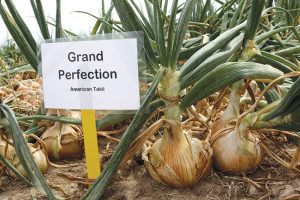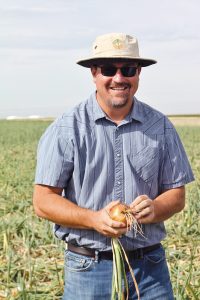Story and photos by Denise Keller, Editor
The Columbia Basin onion industry may eventually be in search of a new go-to product for thrips control. Overuse of some of the most popular insecticides is leading to resistance in thrips, making control of the pest increasingly difficult. Researchers at Washington State University (WSU) are working to quantify insecticide resistance in onion thrips populations in Washington state and shared data during the 2018 WSU Onion Field Day, held Aug. 30 at Hartley Farms near Prosser, Washington.
Adekunle Adesanya, a graduate student with WSU’s department of entomology, is in the first year of a project evaluating insecticide resistance in onion thrips. His study aims to determine which chemicals are effectively controlling thrips and to quantify the level of resistance to chemicals that are no longer getting the job done.

Adekunle Adesanya, a graduate student with WSU’s department of entomology, is evaluating insecticide resistance in onion thrips.
Specifically, he is looking at carbamates. This class of insecticides includes carbamate methomyl, such as Lannate, and carbamate oxamyl, such as Vydate. Both chemicals have been used for thrips control in onion fields for more than 25 years. Adesanya reported on methomyl resistance at the field day and will share the details of the oxamyl portion of the trial later.
This summer, Adesanya sampled thrips populations in five commercial onion fields in Central Washington; sites included one organic field and four conventional fields. Thrips were exposed to varying doses of methomyl and oxamyl. Adesanya then compared the mortality rate of thrips from the organic field to that of thrips in conventional fields. His thought was that thrips collected from the organic field would be more susceptible to the chemicals than thrips from conventional fields.
As he expected, Adesanya found that exposure to the field rate of methomyl resulted in 100 percent mortality of the thrips collected from the organic onion field. In contrast, only 50 to 60 percent of the thrips collected from conventional fields died. The reduction in the efficacy of methomyl on thrips populations in conventional onion fields relative to organic fields indicates that use of the insecticide over time has resulted in field-evolved resistance, according to Adesanya.

Louisa Brouwer helps Adekunle Adesanya demonstrate a technique used to collect thrips and test insecticide efficacy.
“If the thrips are really resistant to this particular insecticide, it doesn’t make sense to continue to spray this product,” Adesanya said. “Farmers need to start looking at other types of chemicals.”
To prevent further resistance from developing, Adesanya reminded field day attendees to use products with different modes of action, pointing out that Lannate and Vydate are similar in their mode of action and target site. He also urged growers to skip insecticide applications if thrips populations are not at a damaging level.
“If you keep doing the same thing over and over again, we might create this super resistant population of thrips. They have resistance to almost anything you try,” he cautioned.
Adesanya plans to test the thrips collected in this summer’s trial for the prevalence of the super knockdown resistance gene that was determined to be universal among thrips populations in Washington state in 2008. This gene was associated with resistance to pyrethroids, notably lambda-cyhalothrin, the active ingredient in products such as Warrior. Onion growers stopped applying this chemical because it became completely ineffective at controlling thrips, Adesanya reported.
“Thrips are a grower’s worst nightmare,” he concluded. “They can cause as much as a 35 percent reduction in onion yield and can reduce the quality of onions if not controlled. They’re a double whammy because they can also transmit <<<Iris yellow spot virus,>>> which can further reduce onion yield and quality. Now, the development of insecticides resistance is more or less a triple whammy because the thrips can do more damage, transmit more disease and also increase the cost of farming.”

American Takii’s Grand Perfection was one of 54 entries from eight seed companies in the cultivar trial.
The next step is to identify the source of resistance in thrips. Knowing this information would help in the development of a molecular diagnostic test for growers to use before spraying as a means of selecting an insecticide to which particular thrips will be susceptible, Adesanya explained.
The research is being funded by the Columbia Basin Onion Research Committee and the Washington State Commission on Pesticide Registration.




